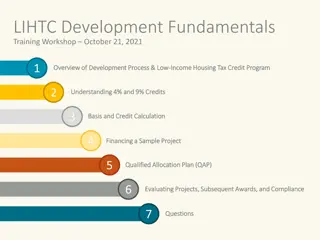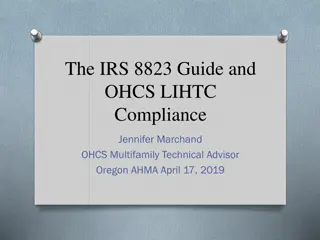Understanding LIHTC Extended Use Compliance
Explore the nuances of LIHTC compliance, including the Extended Use Period, Credit Period, and Compliance Period. Learn about the history, changes, and consequences of noncompliance. Gain insights into the documentation requirements and monitoring processes. Discover how Oregon Housing and Community Services (OHCS) has adapted to ensure compliance.
Uploaded on Dec 10, 2024 | 0 Views
Download Presentation

Please find below an Image/Link to download the presentation.
The content on the website is provided AS IS for your information and personal use only. It may not be sold, licensed, or shared on other websites without obtaining consent from the author. Download presentation by click this link. If you encounter any issues during the download, it is possible that the publisher has removed the file from their server.
E N D
Presentation Transcript
Extended Use for LIHTC Compliance 2014 Oregon AHMA Annual Conference Jennifer Marchand OHCS
Agenda What is the LIHTC Extended Use Period? How does it differ from the Credit or Compliance period? Common Myths when in Extended Use Period What changes in the second 15 years of LIHTC compliance? What documents and restrictions do you follow in the Extended use period? What changes has OHCS made to compliance monitoring in the Extended use period and why? What are the consequences of noncompliance in the Extended use period?
Brief History of LIHTC The federal low-income housing tax credit ( Housing Credit ) was created by Congress in 1986 and is administered in Oregon by Oregon Housing and Community Services (OHCS) Properties awarded Housing Credits in 1987, 1988 and 1989 had a compliance period of 15 years. In 1990 a change in federal law required an additional 15 years of compliance, which is known as the extended use period. As a result, properties that were awarded Housing Credits in 1990 or afterwards must comply with program restrictions for a total of 30 years (or more), subject to certain exceptions. These restrictions are embodied in a recorded real estate document called the extended use agreement.
What is the LIHTC Credit Period? The credit period is the period of time a building s investors plan on taking a tax credit on their federal income tax return. A building s credit period typically starts the year it is placed in service, but the owner has the option of beginning its credit period the year after they place it in service. For example, if a building was placed in service during 2012, the owner may begin its credit period during 2012 or 2013.
What is the LIHTC Compliance Period? The compliance period is the period of time an owner must comply with all program requirements to benefit from their anticipated tax credit. The first year of a building s compliance period is the first year of its credit period. The compliance period lasts for 15 years. It takes an owner 15 years to earn the tax credit the IRS allows them to take over the 10 year credit period. An owner must comply with all requirements established by the IRS and the housing finance agency (HFA) for the 15-year compliance period. During this time period noncompliance is reported to the IRS via form 8823
What is the Extended Use Period? The extended use period (EUP) continues beyond the compliance period for at least 15 additional years. Although the owner is no longer required by the IRS to do what is necessary to produce a federal tax credit, the owner of an LIHTC project signs a regulatory agreement in which they commit to keep their project in the affordable housing inventory throughout its EUP. Every owner and manager must know the requirements for their extended use period based on their regulatory agreement(s), and the compliance monitoring standards established by their HFA for projects past year 15.
Common Myths When In Extended Use Period Myth # 1: My property is not considered an affordable housing property because I am done collecting credits Myth # 2: I don t have to worry about paperwork or compliance audits Myth # 3: My set aside is now 40/60 or 20/50 Myth #4: I do not have to worry about CCPC s or monitoring fees
Extended Use Certification Requirements Currently: All tenants must be verified and certified at move-in Annual certifications are not required Self certifications are not required but recommended Change: All tenants must be verified and certified at move-in Annual certifications may be required if property is found to be in non-compliance Self-certifications will be required for HERA reporting annually
EU Certification Change Why? State Agencies and Compliance Experts have found that the majority of noncompliance errors and instances of fraud that bring into question the validity of the residents initial qualification as a low income tenant are discovered at the first annual move-in. HERA indicates that if any new household is determined to be over- income at move-in, the Owner must re-implement recertification's on all low income households until such time as the Owner can prove that all low income households are income qualified Self Certifications are needed annually in order to provide HUD with the most accurate information on low income Oregonians
Extended Use Student Rule Currently: No Student Restrictions Change: Students will only be allowed if they meet the IRS student exceptions as established in Section 42 regulations Requires: Student certifications will need to be completed by each household annually
EU Student Change Why? Federally a FT student is not considered to be low income or meet low income requirements. The IRS has made it clear that they plan on making this clear in future updates or the next 8823 guide publication. Authority: Code Section 151(c)(4). Reference: Code Section 42(i)(3)(D) Student defined Reference: Code Section 152. Dependent defined
Unit Transfers Currently: Tenant can transfer anywhere in the property in the same building or building to building Change: Tenant can transfer to a unit in the same building but before a tenant can transfer anywhere in the property (building to another building) the property must be part of a multiple building property as indicated on line 8b of the 8609 form
Unit Transfer Change Why If an Owner elects not to treat a building as part of a multiple building property then essentially each building is considered its own project. In this case the tenant must be income verified, qualified, and certified to move to the new building.
Next Available Unit Rule Currently: The policy states that EU properties will no longer be subject to the Next Available Unit Rule but must maintain the unit set-aside Change: The Next Available Unit Rule must be followed
Next Available Unit Rule Change Why Under the Code, special rules apply when an originally qualified Household s income increases above 140% of the applicable income limitation (i.e., 140% above either 50% AMGI or 60% AMGI). Provided the Available Unit Rule is followed, a unit continues to be treated as Qualified even if the household s income exceeds 140% of the applicable income Limitation on recertification. Authority: Treasury Regulation 1.42-15
Monitoring Frequency Currently: Projects will be inspected and audited a minimum of every five years (CO to determine if more frequent reviews are needed). Depending on the size of the project and other factors the number of units and files will range from 5-10% of the unit total with a minimum of 5 units and files. Change: Projects will be inspected and audited a minimum of every five years but most likely no more than three. Units and files may be reduced to less than 20% with a likely total being 10%.
Monitoring Frequency Change Why OHCS is applying Risk Based Management analysis to whole housing portfolio. Five years is a substantial amount of time for a property to go without having a visit. Asset Management is a high priority Nationally. When determining the amount of time between inspections or the amount of units and files to audit, the following will be taken into consideration: Current and past compliance history Owner or Management Changes Tenant Complaints or HUD (Other Agency) complaints etc.
Monitoring Fees Currently: Monitoring fees are reduced in Extended Use to $25.00 per unit for LIHTC and a waiver is offered as an option to properties that have project based subsidy Change: Monitoring fees will continue to be $25.00 per unit for LIHTC in Extended Use however the option for a waiver for project based subsidy properties will no longer be an option
Monitoring Fee Change Why The waiver was originally offered when OHCS Asset Management was able to work with others to inspect units and files. The thought at the time was that the Compliance team would not need to look at the files or inspect the units. However, with the changes that HUD has made with the HUD contract and the RD decision to change inspection frequency for many properties to five year schedules, this waiver option is no longer reasonable.
What Documents and Restrictions do you need to follow in the EUP? Reservation and Extended Use Agreement OHCS Compliance Manual All other funding documents that have restrictions for the property 8609 s
Consequences of Non-Compliance If OHCS is no longer filing 8823 s on the property with the IRS and there is no tax credit recapture consequence, then why should an Owner/Agent care about being in compliance?
Consequences Continued: The status of Owners, managing agents, and or general partners will be designated as not in good standing with the agency Future approvals for funding of properties or approvals of management may be denied Additional monitoring may be required Change in management or site staff may be required A professional consultant may be required to be hired Required third party audits for compliance 100% file and/or physical inspections by OHCS Additional reporting requirements (financials, CCPC etc.) Additional charging of non-compliance fees Required training Future applications for housing credits may be subject to automatic denial OHCS may choose to enforce compliance with the Reservation and Extended Use Agreement through the courts with DOJ opinion
Thank You For Attending For further questions or guidance please contact: Jennifer Marchand LIHTC Technical Advisor/Lead Compliance Officer 503-986-2031 Voice Jennifer.C.Marchand@Oregon.gov (email) Oregon Housing and Community Services 725 Summer Street NE, Suite B Salem, Or. 97309-0409 http://www.ohcs.oregon.gov























